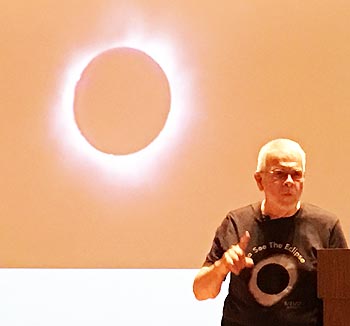Preparing for the solar eclipse

Chap Percival explains that when the moon comes between the sun and earth, the moon casts its shadow and blocks the solar rays, bringing darkness to part of the earth during the day.
The 70-mile-wide path of totality will extend from Oregon to South Carolina, passing through Nashville, Murfreesboro, Sparta, Cookeville, Crossville, Sweetwater, Athens and Clingman’s Dome.
Oak Ridge will not quite be in the path of totality. The sky over our area will gradually darken starting at 1:03 p.m. It will be plunged into total darkness for up to two minutes and 40 seconds, depending on where you are. The sky should brighten at about 4 p.m.
The last time the moon’s shadows in a total solar eclipse crossed our nation from the Pacific to the Atlantic was almost a century ago. On June 8, 1918, the path of totality ran from Washington State to Florida. The next total solar eclipse to cross the U.S. will occur on April 8, 2024.
Chap Percival, who lives in Sarasota, Fla., and has authored the book “Go See the Eclipse,” spoke last week about the upcoming total solar eclipse to a packed auditorium at the American Museum of Science and Energy.
He was a speaker in the 20th annual Richard D. Smyser Lecture Series. Cosponsors of his lecture were Friends of Oak Ridge National Laboratory, UT-Battelle (manager of ORNL), National Park Service and the Oak Ridge Isochronous Observation Network. Dick Smyser was the founding editor of The Oak Ridger.
Percival, a retired high school science teacher and planetarium director, has already reserved a motel room in Cookeville to view the eclipse, the sixth total solar eclipse he will have seen in his life.
He has seen or led groups in viewing five total solar eclipses on four countries: Virginia (1970), Quebec (1972), Aruba (1998), Hungary (1999) and the Sahara Desert in Libya (2006). He showed video of the 2006 eclipse.
“My goal as an educator is to get children involved because I know what seeing a total solar eclipse did for me as a kid,” Percival said. “I know the impact it can have in giving children a lifelong interest in astronomy and science and making that a career choice along the way.”
His goal in writing the book, he added, was to inform young people about the total solar eclipse in the hope they will view the awe-inspiring phenomenon (even though Monday, Aug. 21, is a school day) and consider pursuing a career in science.
What causes a solar eclipse? The moon passes directly between the sun and the earth, and the moon’s shadows fall upon our planet’s surface. A solar eclipse occurs only at the new moon phase, when the moon is only partially illuminated by the sun.
“The sun, moon and earth are in a straight line at the right time and place,” Percival said. The sky will be so dark during totality, he added, that you might be able to see the star Regulus and a few of the planets in our solar system.
The most beautiful part of the total eclipse is the ring of static white fire encircling the sun’s black disk. Percival described this “spectacular, breathtaking and jaw-dropping sight as pearly fumes around the black hole in the sky.” Occasionally, he said, you’ll see a short segment that turns a radiant pink and gives a star-like flash called the “diamond ring.”
The visible ring, or annulus, is actually the solar corona, the sun’s tenuous outer atmosphere composed of the gases it flings out as the sun’s hydrogen burns, forming helium and small amounts of other elements. The longest time that a solar corona will be visible in parts of the U.S. is two minutes and 40 seconds. The only time you can see a corona is during a total solar eclipse.
The corona is visible only during a total solar eclipse, assuming there is no cloud cover (in East Tennessee in August, there is a 40 percent chance of clear skies). You can’t see this relatively faint light during the day because of the intense brightness of the sun’s disk.
Five state capitals will be in the path of totality: Salem, Ore.; Lincoln, Neb.; Jefferson City, Mo.; Nashville, Tenn., and Columbia, S.C. Interstate 80 in Nebraska is completely in the path for 100 miles. NASA has placed a plaque on the ground of an estate in southern Illinois to mark the place where the duration of the total solar eclipse can be seen at its maximum.
Percival said that astronomers and other people from all over the nation and world will come to the U.S. in August to see the solar eclipse. Hotel and motel rooms along the swath of totality are rapidly being booked, and community planners are trying to figure out where so many extra people will park.
“South Carolina is expecting a million people,” he said. “Many will drive down Interstates 85 and 95 from New York and the rest of the Northeast.”
Staring at the sun will probably not blind you but the intense ultraviolent light rays could significantly damage the retinas of your eyes. Percival recommends that if you look at the sun right before and after the eclipse, you should wear certified eclipse glasses, or shades, that you can buy online. If you plan to use a camera, binoculars or telescope, make sure they have the proper filters.
And hope that Aug. 21 is not a cloudy day. “Planning is important but luck plays a role,” Percival said.

